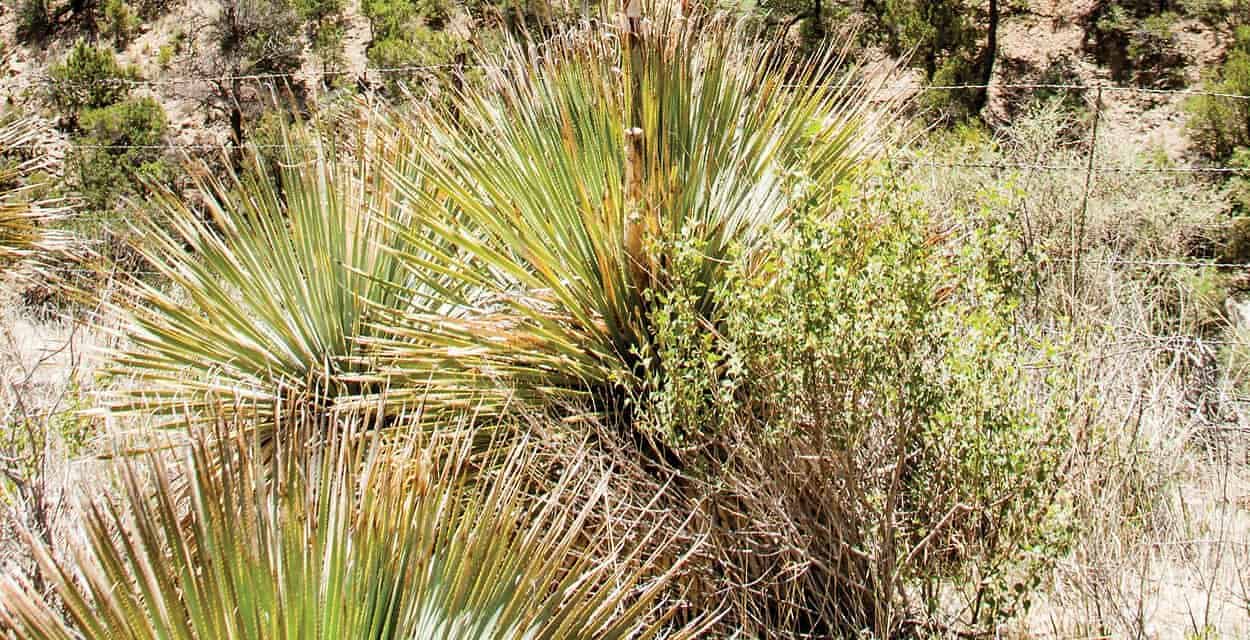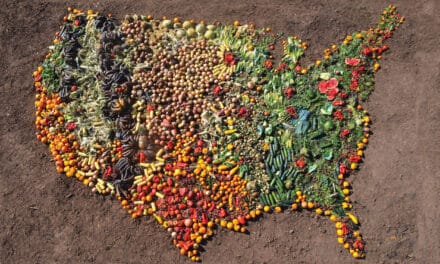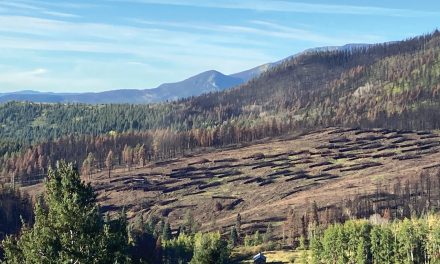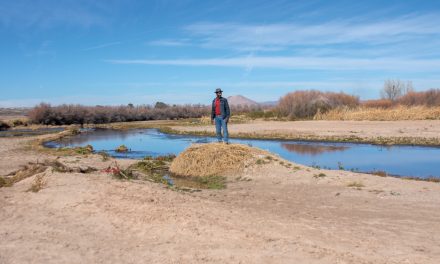A Spirit with the Taste and Smell of the Desert
By Tom Barry

Sotol growing in the southwestern corner of New Mexico. Photo by Stephanie Cameron.
I discovered the drink made from sotol, colloquially known as sereque in Mexico, on a visit to Janos, Chihuahua. While savoring my first copa of sotol, Celso Jácquez, founder and owner of Don Cuco distillery in Janos, explained that sotol could be rightly described as a desert lily. A member of the lily family, its seedling looks like a sprouting onion, nothing like a new yucca or agave, for which it is often mistaken.
One of the most ornamental of desert plants, sotol has what it takes to survive in the extreme heat and hard freezes of the greater Chihuahuan Desert. Found growing as low as three thousand feet and on the slopes of the Sierra Madre Occidental as high as sixty-five hundred feet, sotol thrives where little else will. “Sotol has all the hardy qualities of desert-born Chihuahuenses,” says Jácquez with pride. “Show me the worst of soils on rocky limestone slopes, and that’s where sotol will call home.”
The hardiness, drought tolerance, and beauty of the sotol plant have made it a popular choice among landscapers throughout the arid reaches of the US Southwest, where it has become a standard feature in xeriscaped open spaces along highway medians, in front yards, and outside commercial buildings. South of the border, where the Chihuahuan Desert expands over the states of Chihuahua, Coahuila, and Durango, (and into northeastern reaches of Sonora), sotol is the region’s most pervasive evergreen and is best known as a drink. Many Chihuahuenses, however, will likely tell you deprecatingly that sotol is moonshine alcohol that only “indios” or poor rural mestizos still drink. They might also tell you—correctly—that sotol is central to the revolutionary tradition of Mexico’s arid north, noting that Pancho Villa and his army of rebels drank sotol both as an intoxicant and as a tonic.
The ranchers and farmers who fenced in the southwestern grasslands from the malpais of southeastern Arizona and across New Mexico’s bootheel to the windswept expanses of West Texas didn’t look to the past. As white settlers occupied these arid lands, they rarely integrated the survival habits and wisdom of the original inhabitants. Drinking sotol never found a following in the culture of the US borderlands—until recently.

Sotol tasting. Photo by Tom Barry.
In Cormac McCarthy’s All the Pretty Horses, sotol was doubtlessly one of the most prominent features of the stark Cole family landscape. But cheap whiskey was the drink of cowboys. Young John Grady Cole and his buddy Rawlins saw no future within the confines of the newly fenced-in West. They slipped away one night, crossing an unfenced border into Mexico in search of freedom, adventure, and a future on an open range. For fifty centavos, Cole and Rawlins filled up their canteens with sotol and spent their first couple of days in Mexico intoxicated by a freedom and a spirit they had never before known.
Although sotol spans across the international boundary, like John Grady Cole one must cross the border into Mexico to really know sotol. A new breed of sotoleros—in bars in Chihuahua City or in Janos, Madera, Nuevo Casas Grandes, or Aldama—is recovering the traditions of sotol and is sharing their vision of a new cross-border culture of sotol. The key part of the story of revival begins in Janos, a small town that sits astride Route 9, the two-lane border road that stretches from Ciudad Juárez to Tijuana. Directly south of New Mexico’s bootheel, Janos is a historical hotspot—an Apache settlement where Geronomo’s family was massacred; the Spanish manned a frontier military outpost; and the Franciscans established a mission. Yet passing through on your way to Nuevo Casas Grandes, the Paquimé ruins, or to the potters’ town of Mata Ortiz, you might notice only the Pemex gas station, the diesel-spewing trailer trucks parked along the highway, and taco stands.
Celso Jácquez and his family love sotol. For the past two decades, they have tried to attract Mexican and US visitors to Janos and the Chihuahua–New Mexico borderlands. With their roots in Madera in the eastern foothills of the Sierra Madre, the Jácquez family has since the mid-1990s been at the forefront of sotol’s revival in Chihuahua. Constructing a modern distillery or vinata in Janos, Celso Jácquez has tapped the wild-harvesting, fermenting, and distilling techniques passed down through four generations to create two brands of sol: Sotol Las Generaciones and Don Cuco Sotol.
Don Cuco Sotol is named in honor of Celso’s grandfather Refugio Pérez Marquez, while Las Generaciones refers to the five generations of sotoleros in the Jácquez-Pérez clan, the latest being their son Jacobo Jácquez and his siblings. Celso’s grandfather, known as Don Cuco, revived the dying tradition of sotol production in the late 1800s. In the mountains outside Madera, Don Cuco consulted with his Tarahumara neighbors and his own grandfather who had roasted the piña, or sotol heart, in stone-lined pits, fermented, and distilled the drink for his community since the mid-1900s. His rugged profile appears on the bottles of the Don Cuco brand, which include blanco, suave, reposado, añejo, and crema varieties. Don Cuco insisted on the high-quality of his sotol, making certain that the distilled liquor had the exactly right aroma and collar de perlas or necklace of bubbles when shaken and poured.
“It is truly more of a spirit, like cognac,” explained Jacobo, describing reposado sotol the night of my first visit to Janos. I observed that sotol’s distinctive aroma and taste seemed to capture the essence of the Chihuahuan Desert after a long-awaited rain. Do you know the song “Viva Chihuahua”? asked Celso. I did, but hadn’t until then known the meaning of the verse he began singing: “Tierra que sabe a cariño, Tierra que huele a sotol.” Chihuahua, land that tastes like love, land that has the aroma of sotol.
Don Cuco Sotol and various other brands produced by the Jácquez family have won gold prizes across the nation. Mike Morales, a self-styled tequila journalist who consults nationally for liquor distributors and destination bars, told me of his first experience with sotol and the Jácquez family, much like my own. “I fell in love with this family’s spirit as soon as I inhaled it!” Morales told me. “Don Cuco Sotol carries the best of all worlds. It opens up—blooms—so much that it demands to be treated like a fine wine. It has the smokiness of some of the best mezcals, but the flavor is simultaneously reminiscent of the best tequilas and then, not at all.”




From top left clockwise: Emma and Celso Jácquez in Janos, Chihuahua. Retreiving roasted piñas at Fernández Sotol in Madera, Chihuahua. Rattlesnake in a jug of sotol at Jácquez ranch. Serving samples of sotol at Fernández Sotol. Photos by Tom Barry.
Mixologists from San Francisco and Albuquerque to Mexico City and Chihuahua City now serve sotol either straight like a fine scotch or cognac, or as variety of mixed drinks. Katy Gerwin, the bar manager at Imbibe in Albuquerque’s Nob Hill district, recommends sotol: “Play around a little, slip it in your favorite tequila cocktail for a smoky robust and eco-friendly alternative, or sip it slowly like a fine scotch (especially the Don Cuco Reposado).”
Morales contrasts the environmental and social integrity of artisanal sotol producers, especially the production models created by the Jácquez family, with what he calls the “lies of the liquor industry.” In contrast to the spurious claims of many liquor producers, including a Chihuahua City–based industrialized sotol producer and their unsustainable harvesting and production practices, the Jácquez sotol operation aims to follow the best of sotol traditions.
Many sotol lovers regard the desert spirit as an elixir that is good for all that ails you, and one commonly hears while traveling in Chihuahua about sotol’s medicinal properties, especially for asthma, common cold, diabetes, and rheumatism. There’s no science (that I know of) to back these beliefs. Yet having unabashedly fallen under the spell of sotol, I am not dismissive. When it comes to sotol, I have become a bit of a true believer.
From my first meeting several years with the Jacquez family in Janos – and my first sip of sotol – I have been caught up in knowledge that, as Celso said on that first night holding up a bottle, that what I was drinking was “puro sotol.” In other words, the best of the sotoleros of Chihuahua, keeping to traditional practices, produce a drink that is “sotol and nothing but sotol,” as Jacobo echoed.
Don Cuco Sotol and the other brands produced in its vinata in Janos are unadulterated: Pure desert plant that is baked, fermented and distilled without any water, sugar, or fermenting agents added.
You might become a true believer, too, if, like me, you awake the next morning without a cruda or hangover. Celso and Jacobo explain that it’s part of the natural magic of sotol, but more scientifically it’s because sotol isn’t processed with added sugars like tequila or most other hard liquors. Many repeat occasions of drinking copa after copa in good company (perhaps that’s the secret ingredient) in Mexico have left me cruda-free.
But there are limits to my faith in sotol, at least for now. I don’t, like many in the dispersed sotol community in Chihuahua, start my days with a copa de sotol to keep me in good health, and I haven’t yet tried to heal a cut or lower a fever with a sotol-soaked poultice. But, believe it or not, a few sips of sotol do seem to alter the mind, improve the spirit, and (at least temporarily) heal what ails you.
With good reason, sotol aficionados while savoring a whiff of the Chihuahuan Desert when sipping a copa, will often make a point that sotol is “wild-harvested.” Wild means more than natural. When relishing the desert-imbued bouquet of sotol, you know that what comes out of the bottle is pure wild plant—not one that was planted in an irrigated plantation like the blue agave that produces tequila.
Wild-harvesting sotol requires a burro, endurance, and technique—and the ability to accurately brandish a razor sharp machete on steep inclines. For the select number of sotoleros who are smart and think about sustainability, cutting out piñas is as much about propagating as harvesting. Without regard to sustainability, any rise in the production and consumption of wild-harvested sotol will empty the Chihuahuan Desert of the plant. Demand for wild-harvested sotol could mean that the only sotol left will be found amid the gravel of xeroscaped front yards in Albuquerque.
Wild harvesting, then, doesn’t necessarily signify anything remotely natural or sustainable.
Sotoleros like the Jácquez family in Janos are committed, heart, soul, and wallet, to sustainability in wild-harvesting sotol, which means taking care that their jimadores don’t kill the sotol caudex when harvesting the piña.
But they are also realists. If sotol gains an increased share of the international liquor market, as tequila and mezcal have, then the production of wild-harvested sotol will need to be sharply limited. According to University of Chihuahua agricultural scientist Jesús Miguel Olivas-García, sotol is threatened by increased sotol harvesting, land development, and intensifying periods of drought. Although sotol requires little water to flourish, regeneration requires periodic rains. Prolonged drought and resulting overgrazing dramatically slow the growth of the species, says Olivas-García, necessitating urgent measures to sustainably manage sotol regeneration.
Working with agricultural scientists at the University of Chihuahua, a small group of forward-thinking sotoleros is participating in pilot projects to cultivate sotol seedlings to ensure a renewable crop of sotol plants. Although these cultivated sotol plants won’t be wild-harvested, they will remain natural products of the Chihuahuan Desert, requiring little water and no agrochemicals.
Sotol is also a portal of sorts into our cross-border history—mostly unwritten, but one that archeologists, anthropologists, and regional historians are beginning to chart out. In recovering this past, we may find that despite the border security buildup and our ahistorical belief systems, an invigorating sense of our bio-cultural roots live on in the desert.
~
Tom Barry, a senior analyst at the Center for International Policy specializing in US-Mexico relations, lives outside Silver City in Pinos Altos, New Mexico. Barry is the author of more than a dozen books about Latin America and US foreign policy and is currently working on a book about the transborder water crisis.








